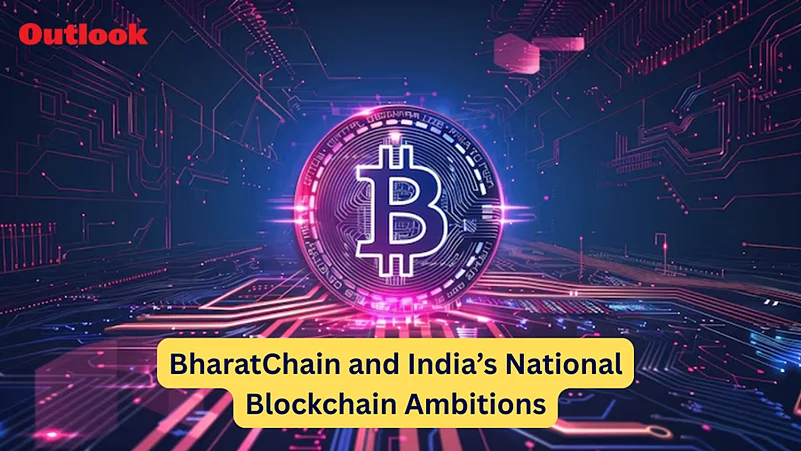Over the last three years, blockchain technology has swept the globe. What was initially infrastructure for cryptocurrencies such as Bitcoin and Ethereum is now being researched for an array of other uses—everything from supply chains to digital identity and record-keeping. India has also recognized the power of blockchain. One of the most significant developments in this area is the launch of BharatChain, India's own national blockchain backbone.
What is Blockchain?
A blockchain is a form of digital ledger. It is an architecture in which data is kept on a network of computers in a format that does not allow it to be altered or hacked. Each transaction or entry is authorized by the network, and once on the blockchain, cannot be erased.
In contrast to traditional databases, blockchain is not dependent on a single server. It is, in fact, decentralized. This implies that no individual or organization controls it. This platform provides transparency, trust, and security—factors of utmost importance in the government, finance, medicine, and more.
What is BharatChain?
BharatChain is India's effort to create a blockchain ecosystem at the national level. It is in the process of being designed to enable government services, public schemes, and electronic governance.
Unlike most company-developed private blockchains employed in a services firm, BharatChain is being developed as a public-good blockchain. What this implies is that it will be open, secure, and accessible for use by not just government ministries but also startups to leverage. It is intended to be a trusted and scalable platform upon which various digital services may be constructed.
This blockchain technology is crypto-unrelated. Rather, it focuses on enhancing storage, verification, and sharing of records. Consider it as an internet backbone to facilitate services like land records, birth certificates, educational diplomas, identity management, and supply chain tracking.
Why is India interested in Blockchain?
India is a highly populated nation with more than 1.4 billion people. Handling data, records, and services on such a large scale is a mammoth task. Data finds itself stored in many locations, processed by many departments, and open to hacking or improper inputs.
Some of these issues can be addressed with blockchain. Since it's an open and tamper-proof network, blockchain is able to introduce more trust into systems. For instance:
Ownership of land can be easily documented, reducing the risk of fraud or dispute.
School diplomas can be quickly checked instantly without physically authenticating them.
Government subsidies and welfare schemes can be easily delivered to the appropriate people.
BharatChain is the logical next step—an attempt to consolidate all these projects into a single national network.
How Will BharatChain Be Used?
BharatChain will enable a range of public and private applications. Some examples include:
e-Governance: Secure and effective public services such as birth certificates, vehicle registration, and police reports.
Education: Secure online diplomas and certificates that can be instantly verified.
Healthcare: Providing medical records to patients and physicians securely.
Supply Chains: Monitoring where products are originating and where they are traveling, particularly in agriculture and healthcare.
Digital Identity: Enabling people to prove that they are who they say they are, particularly in rural India, without relying on paper-based IDs.
Interoperability is likely BharatChain's most important feature. What this implies is that multiple government and private platforms will be able to function as an integral unit on a shared blockchain network.
Challenges Ahead
Scalability: The network must be able to handle millions of users and transactions daily.
Privacy and Data Protection: The sensitive information must be shielded and kept away from misuse.
Awareness and Training: The government employees, developers, and the public will require proper training to learn about the use of blockchain.
Regulations: India requires unmistakable policies regarding the use of blockchain, particularly when handling sensitive issues such as identity, finance, and information sharing.
How well these are addressed will determine whether BharatChain will succeed.
The Bigger Picture
India is not the only one to utilize blockchain. Estonia, Singapore, and UAE are already using blockchain for some government functions. India is giving a very clear message with BharatChain that it is going to emerge as a blockchain-based governance leader.
BharatChain has the potential to make India a global example of applying technology to enhance public services. If handled well, it can accelerate services, make them transparent, and cut down on the paper trail.
But the government also needs to make this technology accessible to all—rural and digitally illiterate citizens in the first place. Then only BharatChain can be a tool for inclusive development.
Conclusion
BharatChain is not merely a technology initiative. It is the onset of a digital India that will be transparent, efficient, and secure. As the nation keeps digitizing infrastructure, blockchain will likely have a central role in shaping the delivery of services to the people.
Today, BharatChain is in the development phase. In the near term, however, it might become a model for how India organizes identity, records, services, and trust online.














